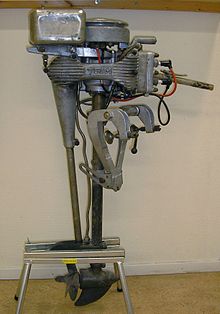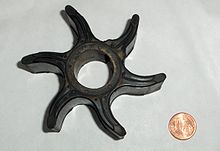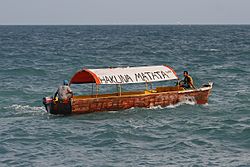- Outboard motor
-
1979 Evinrude 70 HP outboard, cowling and air silencer removed, exposing its shift/throttle/spark advance linkages, flywheel, and three carburetors

An outboard motor is a propulsion system for boats, consisting of a self-contained unit that includes engine, gearbox and propeller or jet drive, designed to be affixed to the outside of the transom and are the most common motorized method of propelling small watercraft. As well as providing propulsion, outboards provide steering control, as they are designed to pivot over their mountings and thus control the direction of thrust. The skeg also acts as a rudder when the engine is not running. Compared to inboard motors, outboard motors can be easily removed for storage or repairs.
When boats are out of service or being drawn through shallow waters, outboard motors can be tilted up (tilt forward over the transom mounts) to elevate the propeller and lower unit out of the water to avoid accumulation of seaweed, underwater hazards such as rocks, and to clear road hazards while trailering.
Contents
General uses
Large Outboards
Large outboards are usually bolted to the transom (or to a bracket bolted to the transom), and are linked to controls at the helm. These range from 2- 3- and 4-cylinder models generating 15 to 135 horsepower suitable for hulls up to 17 feet (5.2 m) in length, to powerful V-6 and V-8 cylinder blocks rated up to 557 hp (415 kW).,[1] with sufficient power to be used on boats of 37 feet (11 m) or longer.
Portable
Small outboard motors, up to 15 horsepower or so are easily portable. They are affixed to the boat via clamps, and thus easily moved from boat to boat. These motors typically use a manual pull start system, with throttle and gearshift controls mounted on the body of the motor, and a tiller for steering. The smallest of these weigh as little as 12 kilograms (26 lb), have integral fuel tanks, and provide sufficient power to move a small dinghy at around 8 knots (15 km/h; 9.2 mph) This type of motor is typically used:
- to power small craft such as jon boats, dinghies, canoes, etc.
- to provide auxiliary power for sailboats,
- for trolling aboard larger craft, as small outboards are typically more efficient at trolling speeds. In this application, the motor is frequently installed on the transom alongside and connected to the primary outboard to enable helm steering.
Diesel
Diesel outboards are available but their weight and cost make them rare.
Electric-Powered
Commonly referred to as "trolling motors" or "electric outboard motors" , electric outboards are used
- on very small craft or on small lakes where gasoline motors are prohibited,
- as a secondary means of propulsion on larger craft, and
- as repositioning thrusters while fishing for bass and other freshwater species,
and any other application where their quietness, and ease of operation and zero emissions outweigh the speed and range deficiencies.
Pump-jet
Pump-jet propulsion is available as an option on most outboard motors. Although less efficient than an open propeller, they are particularly useful in applications where the ability to operate in very shallow water is important. They also eliminate the laceration dangers of an open propeller.
History and developments
The outboard motor, as a portable propulsion system for boats that would otherwise be powered manually by oars, was made possible by the experimentations of Cameron Waterman, a young Yale Engineering student. The Waterman outboard engine appears to be the first real gasoline-powered outboard offered for sale. It was four stroke. Between 1903 and his patent in 1905 he successfully created the outboard. Starting with two dozen built in 1907, the company went on to make thousands of the units in the next 5 years. The inboard boat motor firm of Caille Motor Company of Detroit were instrumental in making the cylinder and engines. Kiekhaefer eventually bought out Cameron Waterman and used magazine ads with references to the Waterman.[citation needed]
The creation of the first practical and marketable outboard motor is often miscredited[citation needed] to Norwegian-American inventor Ole Evinrude in 1909. Between 1909 and 1912, Evinrude made thousands of his outboards and the three horse units were sold around the world. His Evinrude Outboard Co. was spun off to other owners, and he went onto success with ELTO. The 1920s were the first highwater mark for the outboard with Evinrude, Johnson, ELTO, Atwater Lockwood and dozens of other makers in the field.
Historically, a majority of outboards have been two-stroke powerheads fitted with a carburetor due to the design's inherent simplicity, reliability, low cost and light weight. Drawbacks include increased pollution, due to the high volume of unburned gasoline in their exhaust, and louder noise.
In the 1990s, US and European exhaust emissions regulations led to the proliferation of four-stroke outboards. Though fewer in number, four-stroke outboards have always been available. For example, Honda Marine has been marketing small four-stroke outboards since the early 70s. Other brands have been produced for over 100 years, but again in fewer numbers.
Mercury Marine, Mercury Racing, Tohatsu Outboards, Nissan Marine, Honda Marine, Suzuki Marine, and Yamaha Marine, China Oshen-Hyfong marine have all developed new four-stroke engines. Some are carbureted, usually the smaller engines. The balance are electronically fuel-injected. Some models benefit from variable camshaft timing, and multiple valves per cylinder. Mercury Verado four-strokes are unique in that they are supercharged.
Mercury Marine, Mercury Racing, Tohatsu, Yamaha Marine, Nissan and Evinrude each developed computer-controlled direct-injected two-stroke engines. Each brand boasts a different method of DI.
Fuel economy on both direct injected and four-stroke outboards measures from a 10 percent to 80 percent improvement, compared with conventional two-strokes. Depending on rpm and load at cruising speeds, figure on about a 30 percent mileage improvement.[2]
Outboard motors benefit from the use of a submerged pump to draw water for cooling, obviating the need for radiators and cooling fans, thereby simplifying the design and lowering component weight, however constant usage in seawater is liable to cause corrosion.
For boats which are moored rather than trailered, bronze propellers are unsuitable owing to galvanic effects. Quite often sacrificial anodes are found which have been painted over. One can only assume that owners notice that these parts were corroding and thought that the factory forgot to paint them. Severe damage is usually the result.
Outboard motor selection
It is important to select a motor that is a good match for the hull in terms of power and shaft length.
Power requirements
Overpowering is a dangerous condition[3] and underpowering often results in a boat that is incapable of performing in the role for which it was acquired. Boats built in the U.S. have a Coast Guard Rating Plate which specifies the maximum recommended horsepower for the hull. A motor with less than 75% of the maximum will most likely result in unsatisfactory performance.
Shaft length
Outboard motor shaft lengths are standardized to fit 15-inch, 20-inch and 25-inch transoms. If the shaft is too long it will extend farther into the water than necessary creating drag, which will impair performance and fuel economy. If the shaft is too short, the motor will be prone to ventilation. Even worse, if the water intake ports on the lower unit are not sufficiently submerged, engine overheating is likely, which can result in severe damages.
Operational issues
Motor mounting height
Motor height on the transom is an important factor in achieving optimal performance. The motor should be as high as possible without ventilating or loss of water pressure. This minimizes the effect of hydrodynamic drag while underway, allowing for greater speed. Generally, the antiventilation plate should be about the same height as, or up to two inches higher than, the keel, with the motor in neutral trim.
Trim
Trim is the angle of the motor in relation to the hull, as illustrated below. The ideal trim angle is the one in which the boat rides level, with most of the hull on the surface instead of plowing through the water.
If the motor is trimmed out too far, the bow will ride too high in the water. With too little trim, the bow rides too low. The optimal trim setting will vary depending on many factors including speed, hull design, weight and balance, and conditions on the water (wind and waves). Many large outboards are equipped with power trim, an electric motor on the mounting bracket, with a switch at the helm that enables the operator to adjust the trim angle on the fly. In this case, the motor should be trimmed fully in to start, and trimmed out (with an eye on the tachometer) as the boat gains momentum, until it reaches the point just before ventilation begins or further trim adjustment results in an RPM increase with no increase in speed. Motors not equipped with power trim are manually adjustable using a pin called a topper tilt lock.Ventilation
Ventilation is a phenomenon that occurs when surface air or exhaust gas (in the case of motors equipped with through-hub exhaust) is drawn into the spinning propeller blades. With the propeller pushing mostly air instead of water, the load on the engine is greatly reduced, causing the engine to race and the prop to spin fast enough to result in cavitation, at which point little thrust is generated at all. The condition continues until the prop slows enough for the air bubbles to rise to the surface.[4] The primary causes of ventilation are: motor mounted too high, motor trimmed out excessively, damage to the antiventilation plate, damage to propeller, foreign object lodged in the diffuser ring.
Cavitation
Cavitation as it relates to outboard motors is often the result of a foreign object such as marine vegetation caught on the lower unit interrupting the flow of water into the propeller blades.
Preventive Maintenance[5]
- Lower unit gear lubricant—change annually.
- Inspect the old oil for metal fragments and if found, disassemble gearbox for inspection and repair.
- Inspect old oil for evidence of water intrusion and if found, replace seals at propshaft, drive shaft and shift rod.
- Water pump impeller -- replace every two years (annually in a salt water environment).
- Inspect pump housing, and replace if scored or damaged.
- Inspect old impeller for missing pieces and if found, remove thermostat housing and water jacket cover if necessary, to recover the liberated material.
- Powerhead—annual inspection
- Inspect engine wiring for corrosion, burned/chafed/missing insulation. Check all connections for tightness.
- Inspect fuel lines for signs of aging.
- Inspect spark plugs and replace when necessary.
- Check all fasteners for tightness, torque to manufacturer specification if necessary.
- Clean and inspect throttle, shift, spark advance linkages, lubricate according to manufacturer recommendations.
- Starter motor (if equipped) -- apply two drops of light oil to the bendix gear threads.
- Test overtemp warning horn or light (if equipped).
Manufacturers
- British Anzani
- Aquawatt Electric Outboard Motor
- Bolinder[6]
- Briggs & Stratton
- British Seagull
- China Parsun Marine
- ELTO
- Evinrude/Johnson, a division of Bombardier Recreational Products
- Hidea
- Honda
- Honda Marine
- McCulloch
- Mercury/Mariner
- Nissan Marine
- Oshen-Hyfong Marine
- Parsun Marine
- Selva Marine
- Suzuki
- Tohatsu
- Ul'yanovsk Motor Plant
- West Bend
- Yamaha Motor Corporation
- Yanmar Diesel Power
See also
- Air engine
- Electric Outboard Motor
- Luxury yacht tenders
- Sterndrive (inboard/outboard drive)
References
- ^ "Seven-Marine.com: "Seven Marine's 557 Horsepower V-8 Supercharged Outboard."". http://www.seven-marine.com/motors/features-and-benefits/. Retrieved 2011-06-07.
- ^ "Two-Stroke versus Four-Stroke: Who's the Winner?". http://www.marineenginedigest.com/specialreports/2versus4stroke.htm. Retrieved 2008-06-15.
- ^ Standards for Backyard Boat Builders (COMTDPUB P16761.3B), United States Coast Guard, Summer 1993 [1]
- ^ Carlton, John S., Marine Propellers and Propulsion, Elsevier, Ltd., 1994, ISBN 978-07506-8150-6
- ^ Coles, Joan and Clarence, Seloc’s Johnson/Evinrude outboard. Volume IV, L3, V4, and V6, 1973-1991 : tune-up and repair manual, Rancho Cucamonga, CA., USA, Seloc Publications, 1991, ISBN 0893300101
- ^ Bolinder trim story
External links
- "How A Kicker Works, June 1951, Popular Science by George W. Waltz Jr - one of the best basic articles on out board motors with lots of drawings and illustrations
- The Antique Outboard Motor Club International
- The Super-Elto Outboard Motor (1927) Smithsonian Institution Libraries
- Outboard Motor Technology, Diagnosis and Repair
- Outboard-engine.com Outboard engine comparison with brochures, manuals and prices.
- Outboard Manuals Online Manuals for Outboard Motors
- The Antique Outboard Wiki
Patents
- U.S. Patent 1,001,260 - Marine propulsion mechanism
- U.S. Patent 1,011,930 - Canoe and other small craft
Categories:- Marine propulsion
- Marine engines
Wikimedia Foundation. 2010.






